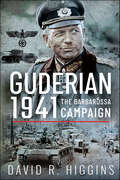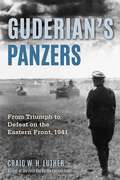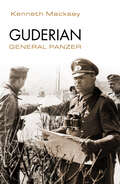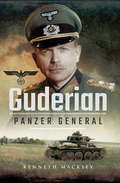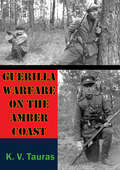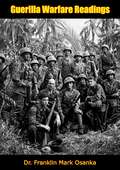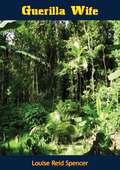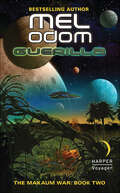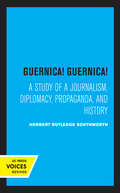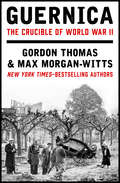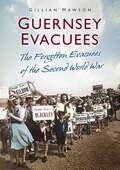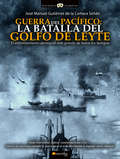- Table View
- List View
Guderian 1941: The Barbarossa Campaign
by David R. HigginsAn in-depth account of the advance of Heinz Guderian’s Second Panzer Group across the central Soviet Union during Operation Barbarossa. During the first few weeks of Operation Barbarossa, Hitler’s invasion of the Soviet Union in 1941, Heinz Guderian's Second Panzer Group played a leading role, cutting through the defenses on the border, then taking part in the massive encirclement battles near Minsk, Smolensk, and Kiev. The extraordinary speed of the advance reflects the experience of the Wehrmacht as a whole during the first phase of the war on the Eastern Front. That is why David Higgins’s graphic narrative, which describes how Guderian’s forces achieved enormous success before they were forced to halt, is such compelling reading. It is a fascinating story, vividly told. Drawing on a wide range of official German and Soviet records, he reconstructs the entire course of Second Panzer Group's advance, covering each stage in unprecedented detail. His narrative offers a German perspective and an inside view of what the opposing commanders knew during each operation and shows how important logistics became as the German supply lines stretched deep into the Soviet Union. It also explains how Soviet resistance and reinforcements, declining strength and the onset of the Russian winter combined to bring Guderian to a stop at Tula where he was relieved of his command. The high hopes with which the German army had launched the campaign were dashed only a few months later before Moscow. This in-depth study the of operations of Second Panzer Group gives the reader a telling insight into what went wrong.
Guderian's Panzers: From Triumph to Defeat on the Eastern Front (1941)
by Craig W.H. LutherFrom unstoppable blitzkrieg to brutal defeat—follow Guderian&’s panzers as they race toward Moscow and collide with disaster. On June 22, 1941, Nazi Germany launched Operation Barbarossa, the surprise invasion of the Soviet Union that opened the Eastern Front in World War II. With lightning speed and devastating success, the German army tore through Soviet territory and rolled over the Red Army, scoring some of the most dramatic victories in military history—until the blitzkrieg bogged down during the approach on Moscow. At the spearhead of the attack was General Heinz Guderian, one of the most celebrated and controversial commanders of the war, who commanded a tank group in the center of the German front that stretched from the Baltic to the Black Sea.Guderian&’s Panzers reconstructs Barbarossa from the perspective of Generaloberst Guderian and his 2nd Panzer Group. With the German war machine at the height of its martial prowess in June 1941, Guderian&’s group of 250,000 men and 900 tanks rapidly broke through the Soviet frontier defenses and thrust some 600 kilometers into Soviet Russia in a matter of weeks--in doing so playing an integral part in the successful encirclement (cauldron) battles of Belostok-Minsk (June/July 1941) and Smolensk (July/August 1941); each of these battles resulting in the loss of several Soviet armies and hundreds of thousands of prisoners. Despite having sustained alarming losses of personal and equipment in these opening battles, Guderian pushed his men, and himself, to even greater achievements, culminating in the triumphant cauldron Battle of Kiev in the Ukraine (September 1941) that obliterated Soviet Southwestern Front and resulted in the capture of over 600,000 Red Army POWs. It was, perhaps, Germany's greatest victory in WWII, and Guderian had made it happen. In October/November 1941, the German Ostheer (Eastern Army) launched a desperate attempt to seize Moscow; and, once again, Heinz Guderian and his tank troops were at the forward edge of battle. Yet, by the end of November, the entire German offensive—exhausted, stretched thin, dangerously reduced in strength, and suddenly largely paralyzed by the fall rain and snow—had ground to a halt. Meanwhile, in early December, the resurgent Red Army launched a major counteroffensive that, in the weeks ahead, not only threatened Guderian's forces with annihilation, but those German Army Group Center writ large. Guderian, and the Ostheer as a whole, were now trapped in a remorseless war of attrition they could never win. Refusing his superiors' orders to stand fast in the face to the advancing Soviet juggernaut, Guderian continued to jerk back in retreat with the remnants of his forces and, thus, was relieved of his command on 26 December 1941. Military historian and Eastern Front expert, Craig Luther, draws on new material, from letters to diaries, to tell the story of Guderian&’s armored force during Operation Barbarossa and fleshes out the story with vivid firsthand accounts from the soldiers who slugged it out with the Red Army on the Eastern Front. The book traces the ups and downs of Guderian and his panzer group during six pivotal months of World War II and explains why and how the Germans, especially its panzers, achieved such impressive successes, only to be defeated on Moscow&’s doorstep.
Guderian. General Panzer
by Kenneth MackseyUna de las obras de referencia de Macksey, uno de los autores especializados en historia militar con más prestigio y reconocimiento. Entre 1939 y 1941, los campos de batalla europeos asistieron al avance, tan veloz como irresistible, de las divisiones panzer alemanas. Polonia primero, y después Holanda, Bélgica, Francia, Yugoslavia o la Unión Soviética, fueron víctimas de la Blikzkrieg, la guerra relámpago. En diciembre de 1941, ante Moscú, los tanques germanos se vieron frenados por primera vez, pero casi todo el continente europeo había caído ya en manos de Hitler. Uno de los padres de ese incontestable éxito fue el general Heinz Guderian. Él superó los principios obsoletos de la Primera Guerra Mundial, inaugurando una nueva forma de hacer la guerra; la clave pasaría a ser la enorme movilidad de los blindados, libres de su atadura a la infantería, y el apoyo de la aviación, en una combinación que resultaría devastadora.
Guderian: Panzer General (Greenhill Military Paperback Ser.)
by Kenneth MackseyBorn in Kulm, Germany on 17 June 1888, Heinz Wilhelm Guderian was the son of an army officer. He eventually joined the German Army and was commissioned in the Jaegers in 1908 where he became a communications specialist. He fought in the First World War and afterwards was a member of the right-wing Freikorps units. Between the wars, Guderian became a catalyst for developing a Panzer division in the German Army. By February 1938 he had been promoted to Lieutenant General; later that year Hitler appointed Guderian to the new post of Chief of Mobile Troops. Guderian was a man of ideas equipped with the ability to turn inspiration into reality. A master of strategy and tactics, he was the officer who led the attack on Poland in September – and in so doing introduced the world to the reality of Blitzkrieg. This biography draws on material from Enigma sources and information taken directly from the extensive Guderian family archives to explore the man who was partly responsible for the development of modern tank warfare and who is considered to be the father of Blitzkrieg. The author also looks at Guderians reaction to the July 1944 plot to kill Hitler as well as illuminates the struggles within the German hierarchy, in the process investigating why Guderian was so admired by some while denigrated by others.
Guerilla Warfare On The Amber Coast
by K. V. TaurasThe historical narrative which unfolds in the following pages is almost completely unknown to Western readers.Guerilla Warfare on the Amber Coast is an authentic, factual history of Lithuanian resistance against Soviet and Nazi oppressors between 1940-1952. This report is based on first-person accounts supplied by people who lived in Lithuania and who were able to reach the West; on statements by defected Soviet officials and military personnel, on articles of the Lithuanian underground press; and on items which have appeared openly in official Communist releases. For the most part, the report concentrates on Lithuanian guerilla operations against the Soviet colonial administration in Lithuania between 1944 and 1952.Most of the first-hand experiences in this narrative were brought to the West by Juozas Luksa, a special emissary from the Lithuanian Freedom Army to Lithuanian institutions in the free world. As a freedom fighter he had used the aliases of Skrajunas, J. Daumantas, and Miškinis. In 1950 he returned to Soviet-occupied Lithuania to rejoin the LFA. According to Soviet sources, the NKVD captured and executed him in about October, 1951.This narrative is published for the record and in the belief that it may serve a useful purpose at this particular juncture in world affairs. Interested readers will find extensive documentation and first-hand accounts of guerilla operations of the Lithuanian Freedom Army in the publications listed at the end of this report.
Guerilla Warfare Readings
by Dr Franklin Mark OsankaThe material in this memorandum supplements readings presented in the volume, Modern Guerrilla Warfare, edited by Franklin Mark Osanka and published in 1962, and together they will give the reader a comprehensive cross-section of the many facets of guerrilla warfare.The first two readings are a concise review of guerrilla warfare from ancient times to the present.The next three readings are devoted to Soviet guerrilla activities against the Nazis during World War II and to current Soviet emphasis on this form of warfare.The last five readings are concerned with counterinsurgency procedures and policies for the future. Atkinson argues that unconventional warfare will play an ever-increasing role in future wars.
Guerilla Wife
by Louise Reid SpencerAuthor account of her time in the Philippines during WW2. Spencer was an American whose husband worked for a mining company.World War II memoir: Author and her engineer husband were living on Masbate, a small island in the Philippines when Pearl Harbor was attacked by the Japanese, and America joined the war effort. When Japan later was occupying the Philippines, they went into hiding and did so for 2 years.True story of family forced into hiding on the small island of Masbate in the Philippines for 27 months during WWII, just after Pearl Harbor was attacked by the Japanese, America joined the war effort, and Japan occupied the Philippines.Louise Reid Spencer’s engineer husband was active in the guerrilla army, and they lived avoiding capture, living off the land like gypsies, giving birth in the jungle, dealing with the murder of their friends, enduring untold hardships, this family and group of people finally made it out via a U.S. Navy submarine.A fascinating personal account that will have you hooked until the last page…
Guerilla: The Makaum War: Book Two (The Makaum War #2)
by Mel OdomThe second installment of the Markaum War series by Mel Odom takes these military sci-fi books to the next level, perfect for readers of Jay Allan's Crimson Worlds novels.He's behind enemy lines. But those lines are shifting beneath his feet.In the jungles of Makaum, the Terran military is locked in a critical standoff over the planet's resources with the hostile Phrenorians, even as both species maintain uneasy relations with the locals. Tensions could ignite at a moment's notice. And Master Sergeant Frank Sage has just stumbled upon the spark plug.Alongside trusted Makaum scouts, Sage is running recon on what is possibly an unsanctioned Phrenorian military base.Deep in the savage wilderness, Sage recognizes the renowned Phrenorian warrior arriving on-site: Zhoh GhiCemid. As Sage knows firsthand, Zhoh's presence could mean trouble.Meanwhile, a mysterious faction of Makaum insurgents breaks the fragile peace with a reckless attack on the Terran base. Before the situation devolves into chaos, Sage must learn to think like his adversaries—devious friends and deadly foes alike.
Guernica! Guernica!: A Study of a Journalism, Diplomacy, Propaganda, and History
by Herbert SouthworthThis title is part of UC Press's Voices Revived program, which commemorates University of California Press’s mission to seek out and cultivate the brightest minds and give them voice, reach, and impact. Drawing on a backlist dating to 1893, Voices Revived makes high-quality, peer-reviewed scholarship accessible once again using print-on-demand technology. This title was originally published in 1977.
Guernica: The Crucible of World War II
by Gordon Thomas Max Morgan-WittsHow and why the cultural and religious capital of the Basque people was reduced to rubble by the Nazi Condor Legion air force. The first—and only—book to have interviewed all survivors of the blitzkrieg and those who launched it.
Guernsey Evacuees: The Forgotten Evacuees of the Second World War
by Gillian MawsonIn June 1940, 17,000 people fled Guernsey to England, including 5,000 school children with their teachers and 500 mothers as 'helpers'. The Channel Islands were occupied on 30 June - the only part of British territory that was occupied by Nazi forces during the Second World War. Most evacuees were transported to smoky industrial towns in Northern England - an environment so very different to their rural island. For five years they made new lives in towns where the local accent was often confusing, but for most, the generosity shown to them was astounding. They received assistance from Canada and the USA - one Guernsey school was 'sponsored' by wealthy Americans such as Eleanor Roosevelt and Hollywood stars. From May 1945, the evacuees began to return home, although many decided to remain in England. Wartime bonds were forged between Guernsey and Northern England that were so strong, they still exist today.
Guerra Submarina: La batalla del Atlantico (Historia Incógnita)
by José Manuel Gutiérrez de la Cámara SeñánLas estrategias de la cruel y despiadada guerra submarina en el atlántico norte, que fue clave para la victoria final en las dos guerras mundiales. La guerra submarina es la gran desconocida en todos los libros de historia. Conocemos las fechas y las batallas terrestres y aéreas, pero ¿cómo participan los submarinos en estos conflictos? A lo largo de este libro conoceremos las distintas estrategias de este tipo de batallas a través de la Batalla del Atlántico (conflicto de suma importancia para las dos guerras mundiales del siglo XX) que se desarrolló en el Atlántico Norte por el dominio de las comunicaciones marítimas, fue cruenta y despiadada, ya que la victoria suponía ganar la guerra. Submarinos, aviones y barcos corsarios, lucharon sin cuartel contra los convoyes que atravesaban el Atlántico para impedir que alcanzasen su destino. A lo largo de estas páginas disfrutará de los enfrentamientos y los detalles de cada encuentro no sólo entre submarinos sino la forma de luchar contra aviones y barcos, sus consecuencias y cómo influyó en el desenlace de ambas guerras.
Guerra del Pacífico: la Batalla del Golfo de Leyte (Historia Incógnita)
by José Manuel Gutiérrez de la Cámara SeñánLa obra describe y analiza la batalla del Golfo de Leyte, que fue la confrontación aeronaval más grande de todos los tiempos, tanto por el número de barcos, aviones y hombres enfrentados como por la gran extensión del escenario de la batalla. En ella se pone de manifiesto el arrojo de unos marinos que estuvieron dispuestos a jugarse todo, en aras del cumplimiento del deber sin que, desde mi punto de vista, la historia les haya prestado todo el reconocimiento que por su labor merecieron. Se analizan con detalle las decisiones de los mandos que intervinieron en el combate, estudiándose con análisis crítico los porqués de tales medidas, haciéndolo a la luz de los principios estratégicos por los que se rige la conducción de un conflicto. Se revisa en su conjunto la guerra aeronaval en el Pacífico, explicando la concatenación de hechos desde el ataque a Pearl Harbour hasta el momento en que tuvo lugar esta importante batalla, que pudo haber cambiado de modo significativo el curso de las operaciones navales para los Estados Unidos, en unos momentos en que nadie dudaba de lo que estaba por venir.
Guerra mundial Z: Una Historia Oral De La Guerra Zombi
by Max BrooksLa crónica de cómo la humanidad se enfrentó a la peor amenaza jamás vista.El final estaba cerca, muy pocos vivieron para contarlo... Sobrevivimos al apocalipsis zombi, sin embargo ¿cuántos de nosotros todavía viven atormentados por los recuerdos de estos tiempos terribles? Hemos derrotado a los muertos vivientes, pero ¿a qué precio? ¿Es solo una victoria temporal? ¿Sigue la especie en peligro de extinción? Contada a través de las voces de aquellos que fueron testigos del horror, Guerra Mundial Z es el único documento que existe acerca de la pandemia que estuvo a punto de acabar con la humanidad. Reseña:«Tiene más creatividad e ímpetu que cajas enteras de nuevos títulos de ficción.»USA Today
Guerra y paz
by Lev TolstóiLos mejores libros jamás escritos Edición de la Academia Soviética de Ciencias Obra cumbre de Lev Tolstói (junto a Anna Karénina) y de la narrativa del XIX, Guerra y paz constituye un vasto fresco histórico y épico. Con la campaña napoleónica -Austerlitz, Borodinó o el incendio de Moscú- como trasfondo, se narra la historia de dos familias de la nobleza rusa, los Bolkonski y los Rostov, protagonistas de un mundo que empieza a escenificar su propia desaparición. Hasta hace pocos años, todas las traducciones de Guerra y paz se basaban en la edición canónica de 1873. Sin embargo, en 1983, la Academia Soviética de Ciencias publicó lo que ellos llamaron la «edición original», es decir, la primera versión que Tolstói escribió en 1866. Es la espléndida traducción de ese manuscrito original, de la mano de Gala Arias Rubio, la que publicamos en estevolumen. «¿Es que se puede estar en paz en los tiempos que corren, cuando se tiene algo de sensibilidad?»
Guerras del siglo XXI: El imperio contra Irak
by Ignacio RamonetUn valiente análisis de las amenazas y miedos que provienen de la mundialización y del desequilibrio entre las naciones tras el 11 de septiembre de 2001. Ignacio Ramonet presenta un retrato del nuevo mundo tras los atentados del 11 de septiembre: la ofensiva de Estados Unidos contra el terrorismo internacional, el recrudecimiento del conflicto israelí-palestino y el ascenso de la ultraderecha en el paisaje electoral europeo. Este nuevo orden viene condicionado por otro fenómeno central, la globalización, cuyos protagonistas no son estados colonizadores, sino empresas y multinacionales privadas dispuestas a dominar el planeta invadiendo mercados en lugar de países. Lo que se traduce en un agravamiento de las desigualdades y en la reiterada destrucción de la naturaleza. Ante esta situación, los ciudadanos reclaman nuevos derechos colectivos que defiendan un medio ambiente a salvo de la contaminación, una ciudad humana, una información no manipulada, así como la paz y el desarrollo de los pueblos. Las sociedades civiles deben reclamar su protagonismo en las grandes negociaciones internacionales. Para cambiar este mundo, hay que soñar un futuro diferente. Reseña:«Junto a la gran cantidad de información que proporciona esta obra en su análisis de la realidad más actual, Ramonet crea, como en las utopías, horizontes inesperados.»Bernabé Sarabia, El Cultural de El Mundo
Guerrilla Leader: T. E. Lawrence and the Arab Revolt
by James SchneiderReclaiming T. E. Lawrence from hype and legend, James J. Schneider offers a startling reexamination of this leader's critical role in shaping the modern Middle East. Just how did this obscure British junior intelligence officer, unschooled in the art of war, become "Lawrence of Arabia" and inspire a loosely affiliated cluster of desert tribes to band together in an all-or-nothing insurgency against their Turkish overlords? The answers have profound implications for our time as well, as a new generation of revolutionaries pulls pages from Lawrence's playbook of irregular warfare.Blowing up trains and harassing supply lines with dynamite and audacity, Lawrence drove the mighty armies of the Ottoman Turks to distraction and brought the Arabs to the brink of self-determination. But his success hinged on more than just innovative tactics: As he immersed himself in Arab culture, Lawrence learned that a traditional Western-style hierarchical command structure could not work in a tribal system where warriors lead not only an army but an entire community. Weaving quotations from Lawrence's own writings with the histories of his greatest campaigns, Schneider shows how this stranger in a strange land evolved over time into the model of the self-reflective, enabling leader who eschews glory for himself but instead seeks to empower his followers. Guerrilla Leader also offers a valuable analysis of Lawrence's innovative theories of insurgency and their relevance to the ongoing turmoil in the Middle East.This exhaustively researched book also provides a detailed account of the Arab revolt, from the stunning assault on the port city of Aqaba to the bloody, Pyrrhic victory at Tafileh, the only set-piece battle Lawrence fought during the Great Arab Revolt. Lawrence emerged from the latter experience physically and mentally drained, incapable of continuing as a military commander, and, Schneider asserts, in the early stages of the post-traumatic stress disorder that would bedevil him for the rest of his life. The author then carries the narrative forward to the final slaughter of the Turks at Tafas and the Arabs' ultimate victory at Damascus.With insights into Lawrence's views on discipline, his fear of failure, and his enduring influence on military leadership in the twenty-first century, Guerrilla Leader is a bracingly fresh take on one of the great subjects of the modern era.Foreward by Pulitzer Prize winner Thomas E. RicksFrom the Hardcover edition.
Guerrilla Nation: My Wars In and Out of Vietnam
by Michael MaclearA celebrated journalist finds himself reporting on the savage war in Vietnam while in combat with his own network. In September 1969, Michael Maclear, the first Western television journalist allowed inside North Vietnam, was in Hanoi for major Canadian and U.S. networks. He recounted in gripping detail how an entire population had been trained for generations in guerrilla combat. His reporting that the North was motivated more by nationalism than Marxism was highly controversial.Later Maclear was taken blindfolded to a Hanoi prison for captive U.S. pilots, some of whom condemned the war. Nixon’s White House said the Canadian reporter was duped, and Maclear’s own network questioned him in those terms on air. Later, the network found reason to dismiss Maclear as a foreign correspondent.Recently, Maclear returned to Vietnam and interviewed surviving key figures from the war. In this book he includes startling new information on guerrilla tactics and delivers an impassioned argument for the necessity of journalistic impartiality and integrity.
Guerrilla Operations in the Civil War: Assessing Compound Warfare During Price’s Raid
by Major Dale E. DavisOne of the most significant areas of guerrilla warfare during the American Civil War occurred along the Missouri-Kansas border. Many of these guerrilla forces had been active during the Bleeding Kansas period and continued their activities into the Civil War supporting the Confederacy. The guerrillas attacked Federal forces and disrupted their lines of communications, raided settlements in Kansas, and attempted to support Confederate conventional forces operating in the area. In 1864, Major General Sterling Price led a raid into Missouri in a final attempt to bring the state into the Confederacy. This thesis explores the nature of guerrilla warfare in the Missouri-Kansas border area and explains how Price and the guerrillas failed to employ the elements of Compound Warfare to bring Missouri into the Confederacy.
Guerrilla Surgeon
by Dr Lindsay RogersDr. Rogers was a New Zealander who, after duty with British troops in North Africa during the early years of the war, made the decision to enter guerrilla warfare in the Balkans and was accepted for training to join the Jugoslav partisans. The account of his experiences, written a decade ago after he had just left the country, has the freshness of recently known people and events and the detachment of a thoughtful mind which could pause to analyse and indicate their meaning for the course of victory and for future Balkan politics. On one level the narrative is full of the scenes of daily life. There are conversations with his aids Bill and Ian (important people in the book), the work in makeshift hospitals, the dangers of movement and escapes and the developing friendships with many of the partisani. But these last, for example, are also geared to show their tendency towards Russian sympathies and the unfortunate handling of British propaganda which made the partisansi think that Britain's main contribution to the war was in helping Mikhailovich. We see too Dr. Rogers' concern with medical methods. He was appalled at the rough and unsympathetic operation room techniques he found among German trained doctors; he saw the possibility for a system of evacuating the wounded to Italy. Eventually he became so valuable that Tito commandeered him from the base in Croatia, where Rogers was beginning to feel at home, to start a medical school in Bosnia. A personal history which is exciting and perceptive enough to hold its own in the war annals market.--Kirkus Book Review
Guerrilla Warfare
by Ernesto Che GuevaraIn this, the most famous book produced by the Cuban Revolution, a charismatic guerrilla leader presents his manifesto on asymmetrical warfare. The Argentine-born Marxist revolutionary Ernesto "Che" Guevara (1928-1967) establishes the principles of waging a popular rebellion, outlining his theories on insurrection and discussing their application in Cuba and elsewhere. Guevara's essays remain remarkably relevant to the twenty-first century, and his example of dedication, commitment, and self-sacrifice continues to inspire freedom fighters around the world.
Guerrilla Warfare
by Ernesto Che Guevara Harry Pombo" VillegasFeaturing a new preface by his guerrilla compañero in Bolivia and Africa, Harry "Pombo" Villegas, this new, expanded and revised edition of a bestselling Che Guevara classic reviews a crucial period of Latin American political history.
Guerrilla Warfare (Stackpole Military History Series)
by William WeirSuccinct accounts of 21 guerrilla conflicts in the twentieth century Wars covered include the Boer War, the Philippine War, World War I, the Russian Revolution, World War II, Vietnam, the Algerian War, the Afghan-Soviet War, and more The exploits of men like Lawrence of Arabia, Orde Wingate, Mao Zedong, and Che Guevera In war, whenever one side outnumbers and outguns the other, the outnumbered and outgunned side often resorts to guerrilla warfare to address the asymmetry and frequently achieves victory. The twentieth century produced scores of such conflicts, whether as sideshows of the world wars or as the main events in wars of revolution or liberation. Guerrilla Warfare examines twenty-one of these conflicts, shedding light on the remarkable capabilities of unconventional fighters to outlast and defeat their enemies.
Guerrilla Warfare Tactics In Urban Environments
by Major Patrick D. MarquesCurrent Special Forces doctrine is very limited concerning the conduct of guerrilla warfare combat operations in urban environments. The focus of the current doctrine is on conducting combat operations in rural environments. The material available on urban environments is defined in broad terms primarily focused on the larger picture of unconventional warfare. Some considerations and characteristics of urban tactical operations are addressed but are so general they could be applied to a conventional infantry unit as easily as to a guerrilla force. Traditionally, Special Forces guerrilla warfare doctrine has focused on its conduct in a rural environment as historically, most guerrilla movements have formed, operated, and been supported outside of the cities. Increasing world urbanization is driving the "center of gravity" of the resistance, the populace and their will to resist, into urban settings. As populations have gravitated to the cities on every continent, the ability to prosecute a successful guerrilla war has often depended on the ability to conduct combat operations in these environments. Predominantly, the aspects of unconventional warfare that were executed in urban settings were those such as intelligence activities, recruiting, sabotage, or subversion. Guerrilla warfare combat operations were done in urban environments only when absolutely necessary.
Guerrilla Warfare: A Historical and Critical Study
by Walter LaqueurAs the author makes clear, every book has a history; Guerrilla Warfare is no exception. Together with its sequel Terrorism (and two companion readers) it was part of a wider study: to give a critical interpretation of guerrilla and terrorism theory and practice throughout history. It did not aim at providing a general theory of political violence, nor did it give instructions on how to conduct guerrilla warfare and terrorist operations. Its aim remains to bring about greater semantic and analytic clarity, and to do so at psychological as well as political levels.While the word guerrilla has been very popular, much less attention has been given to guerrilla warfare than to terrorism - even though the former has been politically more successful. The reasons for the lack of detailed attention are obvious: guerrilla operations take place far from big cities, in the countryside, in remote regions of a nation. In such areas there are no film cameras or recorders.In his probing new introduction, Laqueur points out that a review of strategies and the fate of guerrilla movements during the last two decades show certain common features. Both mainly concerned nationalists fighting for independence either against foreign occupants or against other ethnic groups within their own country. But despite the many attempts, only in two placesAfghanistan and Chechnya were the guerrillas successful.According to Laqueur historical experience demonstrates that guerrilla movements have prevailed over incumbents only in specific conditions. Due to a constellation of factors, ranging from modern means of observation to increase in firepower. The author suggests that we may witness a combination of political warfare, propaganda, guerrilla operations and terrorism. In such cases, this could be a potent strategy for unsponsored revolutionary change. But either as social history or military strategy this work remains a crucial work of our times.
